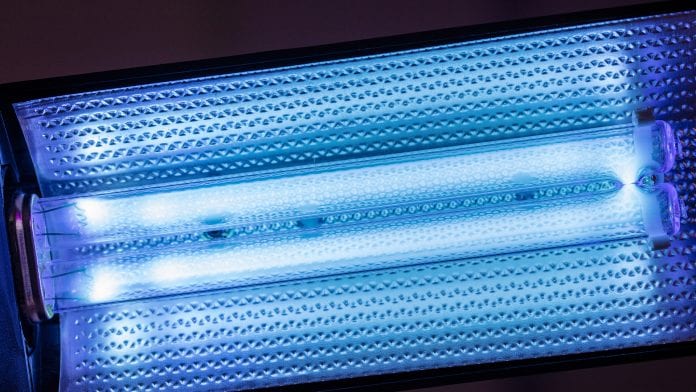
With a wide range of UVC room sterilisation products available, how can users be sure they are selecting the best one?
CW Applied Technology was approached very early on in the pandemic to see if we could develop a UVC-based room steriliser for a very senior surgeon here in Ireland. We were determined not to fall into the trap of prioritising cost over everything else (as our research below indicated that this continues to be an issue in the industry), but also were determined to place a priority on affordability.
We collaborated with a US company, American Air & Water, which has long been established in the germicidal UV market, to develop a product aimed at helping address some of the issues that typically go along with UVC room sterilisation; as well as providing a solution which could be independently verified as effective against both SARS-CoV-2 and carbapenemase-producing Enterobacteriaceae (CPE).
The UVC room steriliser marketplace offers a wide range of products, from the very cheap to the incredibly expensive. Generally speaking, in our experience at least, the incredibly expensive products are more likely to come with some independent verification; but those at the cheaper end are far less likely to offer this – at least, until now.
The market for UVC room sterilisers currently includes a lot of poor quality, cheap products which the manufacturers often describe in terms such as ‘may be effective against COVID-19’ or ‘we expect this will be effective against COVID-19’. For professionals whose job it is to ensure that they use products which make rooms safer, relying on ‘may be effective’ isn’t good enough. As the old saying goes, ‘you get what you pay for’; when you pay little, expect little.
Most of the very cheap UVC room sterilisers come with very little user guidance. Some manufacturers we have seen have had their product tested at a laboratory, but only usually against pathogens like the common cold virus. Then, because the product has been deemed successful in eliminating that virus (although it is not always made clear how long it had to be run for and at what distance from the surface containing the virus), the manufacturer will suggest that they believe it ‘may be similarly effective’ against SARS-CoV-2.
Other manufacturers are leveraging the lack of knowledge on the part of the public regarding what ‘coronavirus’ actually means. Many people believe that there is one coronavirus, which is also called SARS-CoV-2 or COVID-19. The reality is that ‘coronavirus’ is a collective term which applies to hundreds of different viruses, including SARS-CoV-2. If a UVC steriliser claims to reduce, eliminate or kill ‘coronavirus’, the buyer needs to ensure that the manufacturer specifically means SARS-CoV-2. There are many coronaviruses which are substantially less life-threatening, and so it is very important to know that the product has been independently tested on SARS-CoV-2.
As there is often very little user guidance accompanying the UVC room sterilisers being sold, the user cannot be certain that they are using it correctly. Equally, there is very little guidance on runtimes with many of the room UVC products that we have seen. Runtime is critical to ensure that the correct UVC dose to inactivate SARS-CoV-2 is built up at the required distance from the UVC light. In many cases, the reason for the lack of detail on runtimes is that it can take many hours in some cases – if not longer – to develop the required dose.
Many of the cheaper products emphasise features such as motion sensors to switch off the light if someone comes too close to the device, or the ease of placing a device on a table or carrying it to another room. These are certainly nice features to have, but not if the fundamental object of the product – to inactivate SARS-CoV-2, for example – is not fulfilled adequately or in a timely way. If there is no independent verification of effectiveness and no substantial user guidance to try to ensure most effective usage of the steriliser, then everything else is window dressing.
The ‘kill rate’ of these devices is often quoted as 99% or 99.9%. Without knowing runtimes and radius of operation to start with, these figures are more or less irrelevant. The manufacturer is not misleading, as such; they are simply not sharing the most important information, instead allowing the customer to decide on the potential effectiveness of the product themselves based on generalised statements. The product may only be effective at a distance of 10cm from the light over periods of two hours, for example – the buyer cannot be certain. No product should be sold in this way, and certainly not a potentially lifesaving product.
In our opinion, anyone purchasing a UV room steriliser needs to verify three key points:
- Has the steriliser been tested by a Food and Drug Administration (FDA)-approved and/or ISO 17025-certified laboratory and proved effective? If so, effective against which viruses?
- Does the manufacturer provide detailed guidance on room size versus run time? In order to inactivate any virus, a set UVC dose needs to be delivered. The further a surface is from the machine, the longer it takes to build to this correct dose. Unless detailed guidance on this is made available to the user, misuse and potential inadequate UVC exposure are almost guaranteed.
- What ‘kill rate’ is the manufacturer claiming? Is this kill rate the basis for the room size/runtime calculations in question 2?
If you, the buyer, are satisfied with the answers to these questions, then seek to understand:
- How easy is the device to use? Are there clear operating instructions to support the answers to questions 1, 2 and 3 above?
In developing and bringing to market our Muv-X Room UV Steriliser, we have ensured that we are able to answer all four of those questions positively for the buyer.
Can UVC be used against CPE?
The COVID-19 pandemic has now dominated our world for more than 18 months. Had this not been the case, there is little doubt that CPE would be much closer to being a household word than it is today.
In recent years, the medical and scientific communities have recorded the rise of drug-resistant ‘superbugs’, which have developed enzymes as a defence mechanism against even the strongest antibiotics. This has led to higher mortality rates for patients who contract hospital-acquired infections like methicillin-resistant Staphylococcus aureus (MRSA) or E. coli, which can reach as high as 40% to 50%.
CPE is the catch-all name that has been given to a new class of superbug bacteria that are increasingly resistant to modern antibiotics. The acronym stands for carbapenemase-producing Enterobacteriaceae, a scientific description of gut-dwelling bacteria capable of producing enzymes that protect them against even the most vigorous drug treatments. The medical community is now focusing more of its attention on CPE infections, primarily because the carbapenem antibiotics, otherwise known as the ‘drugs of last resort’, are no longer adequate in the treatment of infected patients.
CPE infections are most commonly found in healthcare settings. They can spread quickly when hospital personnel unwittingly carry them from one department to another or use contaminated equipment; and can survive for longer on PVC and metal surfaces like stainless steel than many other bacterial infections. The consequences of CPE transmission can include high-mortality infections in the bloodstream or urinary tract, pneumonia and abdominal abscesses.
Deep-cleaning hospital wards, treatment rooms and operating theatres is a challenging task in normal circumstances. When hospital occupancy rates are as high as they have been during the pandemic, it becomes even harder to protect patients from the risk of infection. Recognising the development of these new superbugs, how they cause human illness and why they can withstand modern medical treatments has become a top priority for the health authorities. That means making the most of new infection control methods, including the use of ultraviolet germicidal irradiation (UVGI) with devices like the Muv-X Room Steriliser to improve cleaning standards in at-risk healthcare settings.
Healthcare settings have responded to COVID-19 and the growth of drug-resistant superbugs like CPE by implementing more stringent disinfection protocols. That has led to the increased use of UVGI, which hospitals have used since the 1930s as an effective sterilisation technique. Ultraviolet light transmitted at short wavelengths will break down the DNA of bacterial infections like CPE and viruses like COVID-19, which prevents them from spreading. Research has shown that some viruses and bacteria will be neutralised more quickly by exposure to ultraviolet light than others.
One key question for us, as developers and manufacturers of the Muv-X Room UV Steriliser, was: could our UV tower product help in the important work of disinfecting surfaces to help prevent the spread of CPE?
What have we achieved in our development of the MUV-X Room UV Steriliser?
Since we launched the Muv-X, we have had it tested at an FDA-approved and ISO 17025-certified laboratory and it proved ‘highly effective in completely removing SARS-CoV-2 RNA’, the virus which causes COVID-19. The conclusion from the laboratory reads as follows:
‘In summary, five coupons on each of three sterile surfaces (stainless steel, white PVC and blue PVC) were inoculated with 100ul of SARS-CoV-2 RNA (1000 copies) and spread across each surface using a sterile wedge and allowed to dry for four minutes. The surfaces and coupons were then exposed to the Muv-X Room UV Steriliser for four minutes.
‘From a review of results presented in this report, it can be observed that the Muv-X Room UV Sterilisers from CW Applied Technology proved highly effective in completely removing SARS-CoV-2 RNA from each of the 15 inoculated coupons when exposed for four minutes at a distance of two metres.’
We also have had the Muv-X tested for effectiveness against CPE at an FDA-approved and ISO 17025-certified laboratory: again, the results have been outstanding and prove the effectiveness of the Muv-X. The conclusion from the laboratory report reads as follows:
‘There was a reduction of 1.8 log in CPE at one metre exposure and zero survival of CPE on white PVC, blue PVC and stainless steel. The Muv-X was 100% effective against CPE. The spike inoculum was 8000cfu/ml CPE.
‘From a review of results it can be observed that the Muv-X Room UV Sterilisers from CW Applied Technology proved 100% effective in reducing CPE from PVC surfaces and stainless steel when exposed at a distance of one metre for four minutes.’
The optimum runtimes for the Muv-X, as set out in our Technical Manual, are focused specifically on SARS-CoV-2 and are calculated based on a 6 log reduction (99.9999%). Many of our competitors claim a 3 log (99.9%) or 4 log (99.99%) reduction. This means that in the case of a surface with 1,000,000 bacteria present, after exposing that surface to a UV room steriliser for the specified runtime (if they specify a runtime), there will be either 1,000 or 100 bacteria remaining respectively, in contrast to the one bacterium which would remain after using a device with a 6 log kill rate, such as the Muv-X.
We have made the product very mobile and easy for users to move from one room to the next without disassembly. This is a critical advantage to ensure repeated use. All the ease of movement of a lower cost product but with the proven capability associated with the higher cost products.
Like all cleaning solutions, UVC has a weakness. In the case of UVC, only air and surfaces to which the light is exposed can be sanitised. Areas in shadow are not sanitised by a Room UV Steriliser. In order to help overcome this weakness, we have made the Muv-X very flexible and scalable. It can be configured in a number of ways:
(i) It can be set on the floor like in the attached picture so that it can shine its UVC light under desks, stretchers, or beds
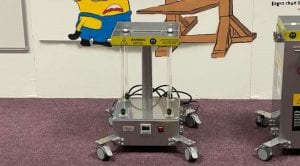
(ii) It can be placed on its stand, as in this picture where it can be positioned to reach high and low touch points
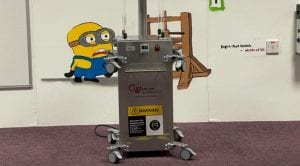
(iii) Two Muv-X devices can be used together to increase both the speed of sanitising and the area which can be exposed – this will also overcome some of the causes of shadowing.
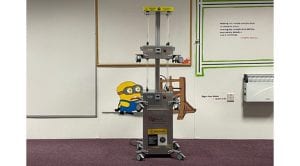
(iv) Three Muv-X devices can also be stacked on top of each other, further increasing the area that can be exposed to UVC light and speed of disinfection
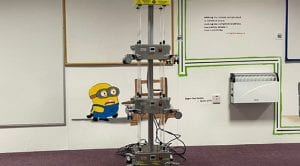
(v) And of course, the Muv-X tower can be built without the stand if you wish
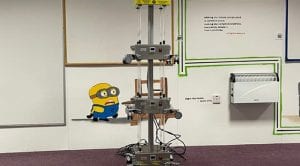
Our Muv-Xh (pictured) was initially developed as mentioned as an emergency to the pandemic. We achieved the goals we had set out for the product in ensuring it is independently verified to be effective against SARS-CoV-2; is user-friendly to encourage continuous use even post-pandemic; is ozone and chemical-free and therefore cannot pose any risk to anyone post-usage, including those with underlying health conditions; and also, very importantly, that it can deliver scalability and flexibility to the user at an affordable price.
The Muv-Xh has now been joined by its little ‘brother’: the Muv-XL. In addition to the above benefits and features, the Muv-XL also offers:
- Motion sensors to switch off the UVC bulbs if someone approaches the machine
- An alarm which sounds (along with flashing light) if the UVC operation is interrupted by someone entering the room and when an uninterrupted run has been completed
- Shock-absorbing castors to allow easier movement over rougher or uneven ground
- A cable tidy
Conclusion
The Muv-X has been proven to be effective against SARS-CoV-2 by an FDA-approved and ISO 17025-certified laboratory. Our technical manual is strong on detail and sets out the necessary runtimes to achieve 99.9999% reduction in SARS-CoV-2. We have also focused on the growing issue of CPE; we have had the Muv-X tested at an FDA-approved and ISO 17025-certified laboratory for effectiveness against this superbug and it passed with very strong results.
We have listened to our customers’ needs in terms of useability, coupled with effectiveness, and have created a very mobile and easy to use machine. Finally, in recognising the key weakness of UVC in terms of shadowed areas, we have attempted to reduce the impact of this weakness by creating a very flexible and scalable machine which can be configured in several different ways.
We started off this article by saying ‘you get what you pay for’. With the Muv-X, we believe this to be more true than ever.
This article is from issue 18 of Health Europa. Click here to get your free subscription today.

























